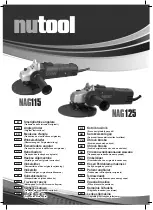
Using Wire Brushes
Wire brushes are useful for removing rust, scale,
burrs, weld slag, etc.
WARNING
Everyone in the area must wear
protective clothing and safety
goggles or face shields. Fatigued wires and
residue will fly off the brush with considerable
force, causing potential for serious injury.
Never exceed Maximum Safe Operating Speed of
brush. Do not use a damaged brush or one that
is functioning improperly (throwing wires, out-
of-balance, etc.). These conditions increase the
possibility of further brush failure and possible
injury. Discard and replace damaged brushes
immediately.
A Type "27" guard must be properly installed
when using a wire wheel brush to provide maxi
-
mum protection for the operator when fatigued
wires break. (See "Removing/Installing/Adjusting
the guard".)
Always install wire brushes according to the acces-
sory manufacturer’s instructions. Only use acces
-
sories with threads matching the tool spindle.
Wire wheel brush
Guard
Nylon
washer
Spindle
Spindle
lock
button
Wire cup brush
Nylon washer
Spindle
Spindle lock button
Test wheel for balance and loose or damaged wires
by letting it spin for one minute before applying it to
the workpiece. During this time, no one should stand
in front of or in line with it.
Control pressure and surface contact between
wheel and workpiece. Too much pressure causes
over-bending of wires and heat build-up causing
premature wire breaking, rapid dulling and reduced
brush life. Instead of more pressure, try a wire wheel
with more aggressive cutting action (increased wire
size, decreased wire length or different brush type
(knot type vs. crimped wire type).
Using Sanding Discs
Hold tool at 5° to 15° angle to ensure proper sanding
pressure and control. Too great an angle will result
in too much pressure and could cause excessive
wear to the disc and workpiece. Too small an angle
will reduce control.
Use long, sweeping, side to side strokes, advancing
forward to produce the desired finish.
Hold at a 5° to 15° angle
For best results use only this portion of disc
Cross Sanding
- When finishing a surface that
has been prepared by a coarse disc or wheel, sand
at right angles to the strokes made by the coarser
disc. Finishing marks left from previous sanding are
easily seen and removed for a uniform finish. Failure
to cross sand when changing from a coarse disc to
a finishing disc may result in deep scratches and
circular marks.
Removing Welds or Hammer Marks
- When remov-
ing welds or hammer marks, limit coarse sanding to
the immediate area. Use successively finer grits to
smooth surface.
Finishing Metal
- Constantly move across the sur-
face. Work faster on curved surfaces where contact
areas are smaller and pressure is greater. Flat areas
may appear at the end of the stroke when pressure
is too heavy. Ease up on pressure at end of each
stroke and when reversing strokes.
Troubleshooting
Deep scratches and circular marks can result from:
• Using too coarse a grit
• Using a partially glazed disc
• Dirt or loose metal on the workpiece
• Failure to sand across the grain when changing from
coarse to finishing discs
• Failure to use closed coated discs to reduce the
problem of grains working loose and scratching the
workpiece
Bluish discoloration of metal surface indicates:
• Excessive heat caused by circular motion in a small area
• Excessive pressure
• Use of worn out or glazed discs
MAINTENANCE
WARNING
To reduce the risk of injury, always
unplug the tool before performing
any maintenance. Never disassemble the tool.
Contact a MILWAUKEE service facility for ALL
repairs.
Maintaining Tools
Keep your tool in good repair by adopting a regular
maintenance program. Inspect your tool for issues
such as undue noise, misalignment or binding of
moving parts, breakage of parts, or any other condi-
tion that may affect the tool operation. Return the tool
to a MILWAUKEE service facility for repair. After six
months to one year, depending on use, return the
tool to a MILWAUKEE service facility for inspection.
Rely only on high-grade power tools on our virtual shelves.




























